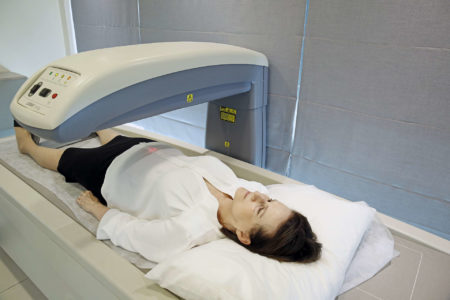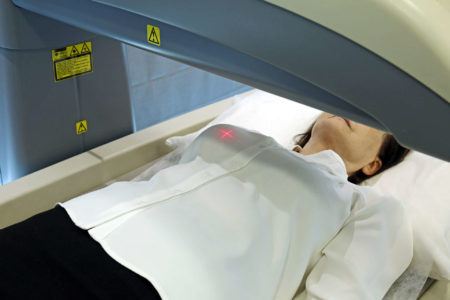Bone density measurement
Digital bone density measurement system
“Diagnostic Mammography” is equipped with an innovative digital system for measuring bone density, the General Electric model LUNAR PRODIGY. This system performs the examination rapidly – in minimum time – receiving an extremely low radiation dose – less than 1/100 that is required for a chest X-ray a fact that enables patients to be revaluated regularly in order to monitor their response to the received treatment. All examination results are stored in digital format and are available for comparative study at each re-examination.
Fat/muscle mass measurement
Another important clinical application of the Prodigy Bone Density Measurement System implemented at the Center, is its ability to measure the relation between fat and muscle mass composition. This examination determines the ratio of fat to other tissues, at a specific part or throughout the body, with high accuracy. This innovative method offers highly accurate results in overweight patients, patients with diabetes, hypertension, and cardiovascular problems, as well as in healthy people taking care of their diet and physical condition.
What do we know about osteoporosis?
Osteoporosis is a gradual progressive condition characterized by the thinning of the density of bones, which thus become fragile and are at a higher risk of fractures even without causing factors. It is a common condition affecting approximately 40% of the female population, especially, after menopause. In most cases, the disease is asymptomatic; this means that it provides no signs in the form of pain, discomfort or other symptoms, and it is diagnosed when the bone thinning is already advanced usually in case of a fracture. Therefore, early diagnosis is critical in preventing disease progression.
Factors implicated in the development of osteoporosis
- Age. It appears mainly after menopause when oestrogen levels are low.
- Premature menopause.
- A family history of fractures.
- Smoking.
- Reduced calcium intake.
- Medication (for thyroid dysfunction, anticoagulants, steroids).
- Metabolic and endocrine gland disorders.
Protecting Factors
According to recent studies, certain factors, such as a balanced diet and daily exercise, appear to prevent the development of the disease.
In the past, it was thought that osteoporosis was an expected condition in older women.
In recent years, advances in science and technological innovations in medicine permit us to measure bone density in order to prevent osteoporosis, or to detect it at an early stage when the disease is still curable.
Furthermore, the use of new technology allows us to identify which women have a higher risk of developing osteoporosis, decades before the onset of the disease. This clinical application is crucial in preventing osteoporosis and avoiding the dramatic consequences (pain, fractures, and permanent disability) caused by its advanced form.
![df[1]](https://mammography.gr/wp-content/uploads/2011/06/df1-150x150.jpg)
![lva[1]](https://mammography.gr/wp-content/uploads/2011/06/lva1-150x150.jpg)
![tbbc[1]](https://mammography.gr/wp-content/uploads/2011/06/tbbc1-150x150.jpg)



